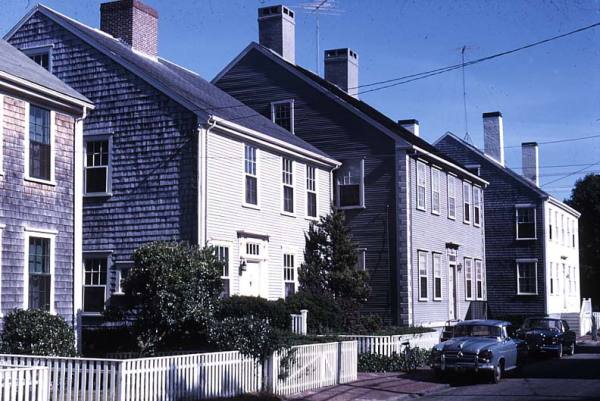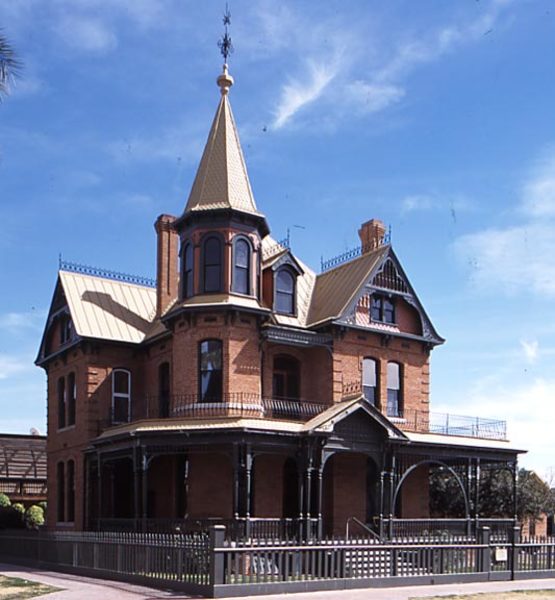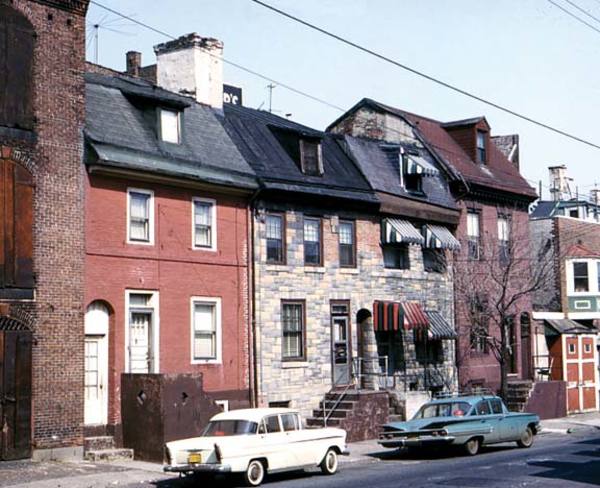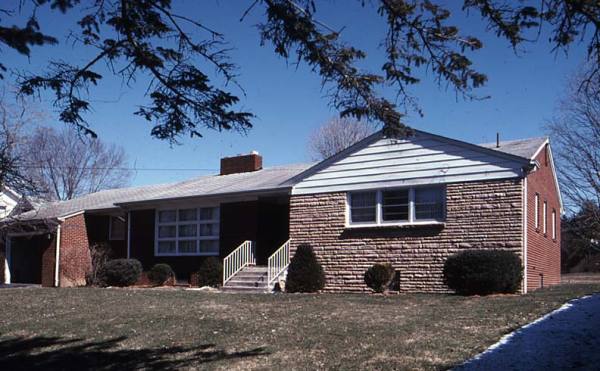
The beauty of Nantucket’s historic neighborhoods derives in no small part from its gable-roofed, gray-clapboarded houses of the 18th and 19th centuries.
It has been said that somewhere in every human heart there stands an old house. We believe that. The house doesn’t have to be grand, illustrious, historic, or even beautiful—except, maybe, in the way that old faces can be beautiful if they belong to good people.
On the other hand, it also has been said (in the iconic 1970s movie Chinatown) that “Politicians, ugly buildings, and whores all get respectable if they last long enough.” That may be true, too.
Thirty-five years ago, when Old-House Journal was born, not every heart had room for an aging Victorian vision of architectural splendor. Likewise, today, there are hearts with no soft spot for the postwar Colonial Revival house that sheltered the Cleaver family in the beloved 1960s Leave It to Beaver television series. So, what makes a house old enough to matter—and good enough to love?
There are as many answers to that question as there are hearts to answer it. For 20 years or so, we’ve been picking away at the issue in our OHJ articles on historic architectural styles. From Colonial to Greek Revival to Arts & Crafts to Modern, we’ve fallen for another old house—or 60—several times a year. We simply love them all.
The official answer to the age-equals-goodness question belongs to the National Register of Historic Places, the federal government’s official list of U.S. buildings, districts, sites, and objects that are historically, architecturally, or culturally significant. The Register lists buildings as young as 50 years of age—even younger if there are compelling arguments for inclusion.
That bothers some people. Prevailing wisdom dictates that objects need to age at least a hundred years before they can be considered antiques, and many believe the same should hold true for buildings.
Architectural Integrity

High Victorian houses like the 1895 Rossen House in Phoenix, Arizona, were seriously underappreciated only a generation ago.
The 50-year rule doesn’t bother us. History moves too fast, and the wrecking ball never sleeps. We do think enough time has to elapse to allow the building to be seen in the context of its own time and in comparison with, or in contrast to, the buildings that came before and after it.
As to style, we love ‘em all, remember? The world may worship Greek Revival, detest modernism, and yawn at some other architectural form, but personal taste is, well, personal.
Not that we don’t have standards. Like the National Register, we favor integrity. No radical cosmetic surgery, no inappropriate augmentations or amputations, no “earlying-up” (the architectural equivalent of fudging your resume). Too much of that, and you have a whole new building that will have to wait another 50 years before its worth can be known.
Good design is a plus, though it needn’t be fancy. Venturi and Rauch’s Nantucket cottages have their place in our hearts, along with Robert Mills’ mansions and Frank Furness’ brick and stone city houses. Frank Lloyd Wright’s little Usonian homes are as welcome as his Fallingwater extravaganza. Barely-heard-of or anonymous designers can rate high with us if their work is honest, appropriate, and attractive.
Well-chosen materials—wood, brick, marble, even concrete—that have stood the test of time are excellent recommendations. And it’s better still if they represent early uses of materials that have become old standbys, such as the postwar Lustron house’s original porcelain-steel panels. Even faux materials, such as manufactured stone, are legitimate if they’re age-appropriate. (We do, however, draw the line when we see 20th-century permastone facings on 19th-century houses.)

Age doesn’t always guarantee respect—many 18th-century houses, like these along the Delaware River in Philadelphia, were demolished for the construction of I-95.
Neighborhoods Matter
Good old buildings and their surroundings share a mutual history. That’s one reason preservationists like historic districts and neighborhoods. The presence of many houses of compatible design and comparable age in near-original settings enhances them all—and gives old-house watchers more bang per block.
Context is key. Consider the ubiquitous post-World War II ranch house, few of which are architecturally distinguished as individual entities. Except for a mixture of building materials (brick, wood, stone, shingles) and the popular big masonry chimney, they are undecorated. To the untrained eye, they all look alike. And they’re small—often 1,000 square feet or less, and just one story. Worst of all, there are so many of them!
But that’s the whole point. Though the house itself may be practical, even charming, it makes little sense without a neighborhood filled with similar houses. The ranch house is no prima ballerina; it begs to be viewed as part of the ensemble. It needs its neighbors—and its neighborhood’s traffic-calming curving streets and cul-de-sacs—to establish its character as a family-friendly, neighborly kind of house. The original Levittown, once maligned as a ticky-tacky, populist purgatory, is as viable today as it was when house-hungry WWII vets and their families moved there six decades ago. The houses aren’t big, they aren’t impressive, but they are loved.
More stylish and thus less problematic than the ranch house is the postwar style we call “soft modern.” Contemporaneous with the ranch, it was (and is) treasured by suburb dwellers with non-traditional tastes—and maybe a bit more cash. It falls between the pedestrian leanings of the ranch and the hard lines of true modern (à la Philip Johnson’s Glass House). Soft modern is comfortable, clean, warm, and outdoor-oriented in a more overt way than the ranch. Playing up its imaginative use of materials, it also is likely to be found in smallish, open-plan houses sited on small lots on curving streets, and accompanied by naturalistic landscaping with native plants and few sidewalks. Plenty of people love this house—Eichler aficionados in California, Charles Goodman fans in D.C. suburbs such as Hollin Hills, and Arapahoe Acres admirers in Colorado.
The Split-Level & Beyond

Ranch houses like this one in Union, West Virginia, were the height of style in the 1950s and 1960s and are now becoming popular once more.
But what about that other ubiquitous mid-century style—the split-level? It has more than its share of detractors, but lately it’s been garnering a fair number of new enthusiasts. Time, along with the vertical lifestyle required by many of today’s townhouses, has made the split-level’s six-steps-up, six-steps-down approach more attractive. It certainly proved helpful a generation or two ago by economically using small, irregularly shaped, uneven building lots (left over, perhaps, after the flat potato fields that enabled Levittowns were built out). More ample than ranch houses, split-levels divided the house into discrete areas: the public entry hall a few steps up from the front walk, the living room and kitchen a few steps down from the entry, and bedrooms above the attached garage (the residents’ preferred entrance and home to that all-important postwar family member, the automobile).
Once, only houses from our “colonial” past (the 17th century to 1840) seemed important. Until the 1960s, anything built after the Civil War was suspect. Even the beloved early 20th-century bungalow had to wait its turn to become “old enough.” Until recently the ranch, split level, and soft modern house seemed way too young to merit respect from the old-house crowd. But that’s changing. Now Americans can look at buildings from the recent past with curiosity and interest, if not always with admiration.
Which will be the good old houses of 2043? Will we love today’s split-foyer as well as the old split-level? How many 1990s cathedral ceilings will have been foreshortened by the addition of “mezzanine” floors? Will 6,000-square-foot McMansions be the great houses of the future? Will the post-modern Palladian window turn out to be full of cracks? The answers to those questions will undoubtedly educate and entertain us all. In the meantime, let’s cherish the good old houses in each of our hearts. Long may they stand!







